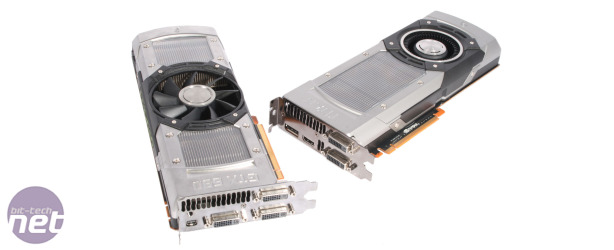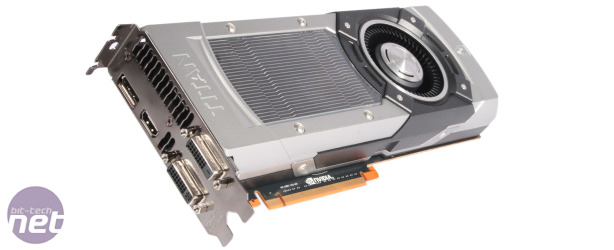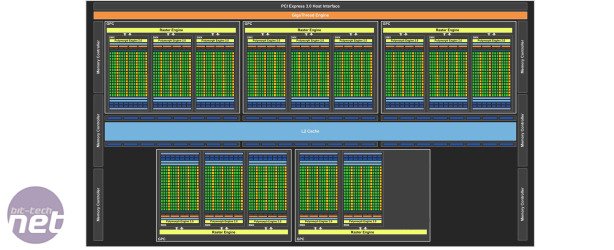Nvidia GeForce GTX Titan First Look
Manufacturer: NvidiaUK Price (as reviewed): MSRP £830 (inc. VAT)
US Price (as reviewed): MSRP $1000 (ex. Tax)
As much as we’re excited to be bringing you today’s review of the Nvidia GeForce GTX Titan 6GB, it might be the last major GPU launch for quite a while. With AMD announcing that there’ll be no new top-end Radeon GPUs until 2014 (possibly due to its focus on making chips for the PS4 and, likely, the Next-Box) and Nvidia’s Maxwell architecture on a similar time-line, the GeForce GTX Titan 6GB could be the last major GPU launch for a while; let’s hope it’s a good one.
We covered much of the new card’s architecture in our GTX Titan First Look earlier this week, but here’s a brief refresher. The GK110 GPU at the heart of Titan is the 28nm evolution of the GPU found in last generation’s GTX 580 1.5GB. To date, 6-series cards have used the GK104 GPU, based on the GF114 GPU of the GTX 560 Ti, so this step up to what could be considered a full-fat Kepler GPU is a significant one.
While the core architecture design is the same, with the GPU divided into GPCs (Graphics Processor Clusters) and then sub-divided into SMXs (Streaming Multi-processors) of 192 stream processors running on a unified clock speed, GK110 has a whole lot more of all three than the GTX 680 2GB. Five GPCs (to the 680’s four) each comprised of three 192-stream processor SMXs (to the GTX 680’s 2 SMXs per GPC) mean the GTX Titan sports 2,688 Stream Processors, a 75 per cent increase over GTX 680.
The higher number of SMXs also means far more texture units (224 vs. the GTX 680’s 128) and more tessellation units (14 vs. the GTX 680’s 8). The ROP count has also increased from 32 up to 48. The GPU’s memory interface is also far more capable, with six 64-bit memory controllers offering a 384-bit memory interface that, finally, matches that of HD 7970 3GB. With a price tag of over £800, there’s no holding back from Nvidia on the amount of memory either, with the GTX Titan equipped with 6GB of 1.5GHz (6GHz effective) GDDR5 for a total of 288GB/sec memory bandwidth.
As with the rest of Nvidia’s 6-series cards, the GTX Titan makes use of GPU boost to dynamically adjust its clock speeds to optimise performance within its thermal, voltage and power consumption parameters. All cards are guaranteed to run at 836MHz base clock, with a typical boost clock of 876MHz. However, our review sample frequently boosted to over 993MHz at its stock settings in single-card testing, with the new version of GPU Boost allowing users to customise the Boost curve to a significant degree. Want to consume less power, run cooler or quieter? The card will automatically adjust its curves to suit. We’ll be putting this to the test when it comes to overclocking.

Click to enlarge - With the same price tag, how does the GTX Titan 6GB (right) stack up against the GTX 690 4GB (left)?
The card itself is decked out in the magnesium and aluminium casing that we’re already familiar with from Nvidia’s GTX 690 dual-GPU card, with some optimisations to suit the large 7.1 billion transistor, 551mm² GK110 GPU. At 267mm it’s actually slightly shorter than the GTX 690, with a radial fan drawing in in and over a small rear heatsink fitted atop the card’s power circuitry. Air is then blow over the card’s main aluminium fin stack, which sits atop a vapour chamber to transfer heat from the GPU, before exhausting out of the card’s rear IO. Again, we’re casting a brief eye over the card here; for more analysis, check out our more in-depth first look; today's all about the benchmarks.
GeForce GTX Titan 6GB Specs
| Nvidia GeForce GTX Titan 6GB | Nvidia GeForce GTX 690 4GB | Nvidia GeForce GTX 680 2GB | Nvidia GeForce GTX 670 2GB | Nvidia GeForce GTX 660 Ti 2GB | ||||||
| GPU | ||||||||||
| Codename | GK110 | 2 x GK104 | GK104 | GK104 | GK104 | |||||
| Base Clock | 836MHz | 915MHz | 1,006MHz | 915MHz | 915MHz | |||||
| Boost Clock | 876MHz | 1,019MHz | 1,058MHz | 980MHz | 980MHz | |||||
| Stream Processors | 2,688 | 2 x 1,536 | 1536 | 1344 | 1344 | |||||
| Layout | 14 SMs, 5 GPCs | 2 x 8 SMs, 4 GPCs | 8 SMs, 4 GPCs | 7 SMs, 4 GPCs | 7 SMs, 4 GPCs | |||||
| Rasterisers | 5 | 2 x 4 | 4 | 4 | 4 | |||||
| Tesselation Units | 14 | 2 x 8 | 8 | 7 | 7 | |||||
| Texture Units | 224 | 2 x 128 | 128 | 112 | 112 | |||||
| ROPs | 48 | 2 x 32 | 32 | 32 | 24 | |||||
| Transistors | 7.1 Billion | 2 x 3.54 Billion | 3.54 Billion | 3.54 Billion | 3.54 Billion | |||||
| Die Size | 551mm² | 2 x 294mm² | 294mm² | 294mm² | 294mm² | |||||
| Process | 28nm | 28nm | 28nm | 28nm | 28nm | |||||
| Memory | ||||||||||
| Amount | 6GB GDDR5 | 2 x 2GB GDDR5 | 2GB GDDR5 | 2GB GDDR5 | 2GB GDDR5 | |||||
| Frequency | 1.5GHz (6GHz effective) | 1.5GHz (6GHz effective) | 1.5GHz (6GHz effective) | 1.5GHz (6GHz effective) | 1.5GHz (6GHz effective) | |||||
| Interface | 384-bit | 2 x 256-bit | 256-bit | 256-bit | 192-bit | |||||
| Bandwidth | 288GB/sec | 2 x 192GB/sec | 192 GB/sec | 192 GB/sec | 144 GB/sec | |||||
| Card Specifications | ||||||||||
| Power Connectors | 1 x 6-pin and 1 x 8-pin PCI-E | 2 x 8-pin PCI-E | 2 x 6-pin PCI-E | 2 x 6-pin PCI-E | 2 x 6-pin PCI-E | |||||
| Stock Card Length | 267mm | 279mm | 257mm | 240mm | 240mm | |||||
| TDP | 250W | 300W | 195W | 170W | 150W | |||||
| Typical Street Price | £830 | £830 | £370 | £300 | £240 | |||||

MSI MPG Velox 100R Chassis Review
October 14 2021 | 15:04











Want to comment? Please log in.